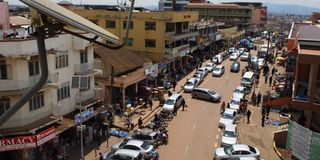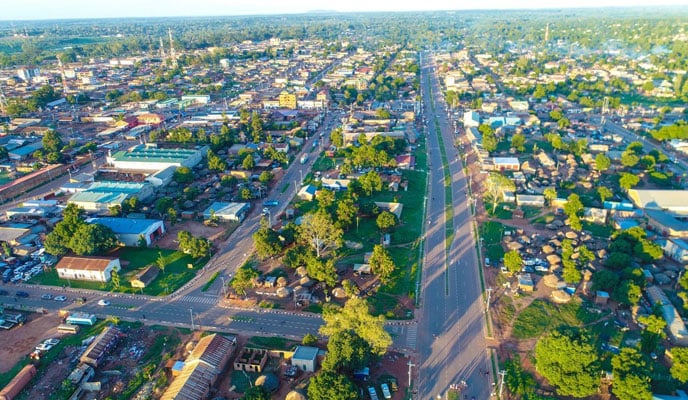Prime
Planning concerns as Mbarara races to catch up with city status

Part of Mbarara city as viewed from Buremba road. PHOTOs/RAJAB MUOKOMBOZI
What you need to know:
The problems in housing, infrastructure and physical planning are a result of shortcomings inherent in both the city leadership and its various agencies, as well as the urban poor themselves
In theory cities always get bigger, but what happens when there is no more space for expansion? This is one of the challenges Mbarara, which was elevated to city status on July 1, 2020 is grappling with. Even before turning into a city, Mbarara, due to its strategic position was a melting pot. But in the 2000s the city went through a rapid growth with a lot of infrastructural developments including a host of arcades, shopping malls, hotels and apartments cropping up. This unprecedented growth brought with it concerns of physical planning, waste management, traffic congestion and proper supply of essential services such water and electricity.
Issues at hand
But the problem is not single-cause in nature, and many factors contribute to the disturbing situation and conditions in Mbarara City today. The problems in housing, infrastructure and physical planning are a result of shortcomings inherent in both the city leadership and its various agencies, as well as the urban poor themselves. Within the city council, shortcomings such as inadequate financial resources, ineffective institutional structures, weak legislation or their implementation, lopsided policies and lack of adequate trained manpower have compounded the challenges. Then there is the social problem of the urban poor themselves who lack assets, have low skills and education levels and consequently depend on low income jobs. The city is grappling with all these challenges as the population encroaches on its gazzeted areas such as wetlands.
For example the city’s main drainage channel that stretches from Kajogo, Biafra, Saveya, Makenke to Koranorya has been reclaimed for housing. A source reveals that the wetland was embanked to enable construction of commercial and residential properties.
As a result, the area is already being affected by flooding, poor sanitation and hygiene, poor waste management and thus providing breeding grounds for organisms such as mosquitoes.

Some of the uncontrolled settlements in Biafra, Kakiika , Mbarara North Division.
While in the city centre there seems to be visible physical planning efforts, in the periphery, especially the new divisions of Biharwe, Kakiika and Nyakayojo that were added to the former three divisions of Mbarara Town (Nyamitanga, Kakoba and Nyamityobora) to make it a city, the peri-urban areas remain characterised by uncontrolled and unplanned settlements. These areas were formerly farmlands that are now being overtaken by mushrooming trading centres and unplanned urban settlements. For instance the settlements lack basic services such as road infrastructure, water and electricity for their ever-growing population.
The deputy mayor of Mbarara City, South Division Jomo Mugabe, reveals that the city has not yet planned for these newly acquired areas. “We had hopes that these areas would give a new face to Mbarara City through proper physical planning but they are also going to waste. There are many illegal structures coming up but we have no capacity to stop them, we are not funded, the city physical planning office has only one staff, that is a physical planner,” says Mugabe.
Lack of resources
He adds that even the city agents that could have assisted in enforcing physical planning are compromised and end up being agents of illegal constructions.
Mugabe decries the authorities’ failure to prioritise proper planning which he reckons not only has a negative impact on the city’s aesthetics but also presents an administration challenge.
“I am seeing the same pattern of mismanagement that happened in the former divisions when Mbarara was still a municipality such as sanctioning encroachment on water bodies and illegal structures, happening in these new divisions which we had hoped would enable us construction of a modern and smart city,” Mugabe says.
He however, appeals for government support in terms of funding and human resource for Mbarara City to be transformed into a planned city.
“The city’s planning department is underfunded and understaffed, we need the intervention of the Ministry of Lands, Housing and Urban Development to address these pertinent issues before they get out of hand,” Mugabe says.
Population challenges
Alex Beyendeza, a resident of Koranorya in Mbarara City, North Division, blames the city’s planning challenges on the unmanageable influx of population that come expecting a better life but end up working and living in squatter settlements making a living with the few informal resources that are accessible to them.
“When the rural migrants arrive here, they discover that the housing, jobs, incomes and amenities that had attracted them to the city are not available or are inaccessible to them. There are no public resources such as housing to help them in the meantime as they improve their economic situation, so their option is to settle in the already teeming slums and competing for the poor paying jobs. This creates a poverty-stricken population that is a burden to the city and community,” explains Beyendeza.
Amos Bwengye, a resident of Kakiika in Mbarara City, North Division says local authorities should learn from the challenges faced by Kampala City and therefore begin to treat proper planning with the seriousness it deserves.
“I think Ugandans learn the hard way, challenges such as flooding, traffic congestion, pollution, poor waste management that Kampala City is facing because of poor planning should have served as an example to authorities in Mbarara City, but they have not, ”notes Mr Bwengye.
Mbarara City has a number of slums whose population is increasing daily. Some of these slums are Biafra, Kajogo, Kisenyi and Kijungu. Bwengye advises that whereas past leaders might have neglected physical planning that led to the growth of slums and some illegal structures in the city, the new leaders should take bold steps to resolve the issue.
Abel Anania, a resident of Karama in Nyakayojo Division, Mbarara South also notes that the problem of uncontrolled development has spread to semi-urban areas such as Karama, Rwakishakizi, Kicwamba and Kitagata.
“There is a mad rush for land here as developers anticipate developments to scale up here but also speculation in the increasing demand and cost of land in the future. And this expectation has already attracted uncontrolled developments,” explains Anania.
Abdu Mwesigwa of Kakoba, Mbarara South, ominously points out that some areas such as Kijungu are a disaster waiting to happen due to overcrowding. “When one walks through Kijungu, they are shocked by how irresponsibly structures have been allowed to be constructed. There are no access roads or any sort of service lane. In case of an emergency such as fire, the whole place has the potential to burn down since services such as fire fighters would have no access,” Mwesigwa notes.
Alice Kyobutungi, a person with disabilities (PWD) from Kakiika, North Division notes that even some of the buildings and arcades being constructed have ignored the building standards, for example provisions for accessibility by PWDS.
“Mbarara as a new city should make sure it complies not only with the Physical Planning Act but also with all laws and regulations such as the Building Control Act and Occupational, Safety and Health Act,” she explains.
According to the Building Control Act 2013 and National Physical Accessibility Standards and Requirements, buildings should have the possibility for any person to access every place, use service to participate in activities provided in a public place with dignity, independence and safety on an equal basis with others.
Efforts
The city mayor Robert Mugabe, acknowledges the current physical planning challenges but states that the city is trying to correct those mistakes.
“Under my leadership, we are cracking down on illegal construction. Every structure must be approved after it passes our physical planning standards and compliance tests,” says Mugabe.
He adds that they still have challenges in peri-urban areas surrounding the city. “While it is easy to enforce these regulations on permanent structures it becomes redundant tasking someone building a hut to get approvals,” Mugabe notes.
The deputy town clerk, Richard Mugisha says there may be a few challenges but physical planning remains a priority. For one to put up a new building, they have to apply to the building control committee, physical development committee and then the technical assessment committee, adding that, “Before we were elevated to the city status, the physical planning was mainly with concerned physical standards and demarcating spaces for specific businesses such as markets and bus parks. But now we have to consider issues such as traffic congestion where we have tasked every new development to provide parking space.”
He adds that the new buildings coming up in the areas of Nyamitanga, Kakoba and Kamukuzi can be constructed on a minimum piece of land of 50 by 100ft while the minimum requirement for areas of Nyakayojo, Kakiika and Biharwe should be 100 by 100ft to prevent these areas from developing into slums.




